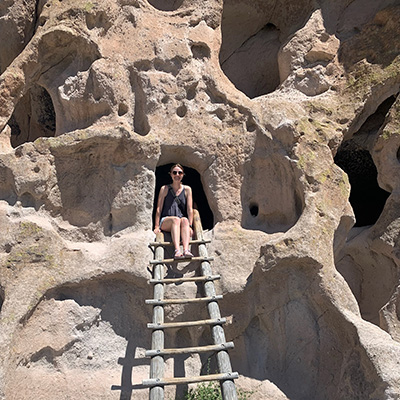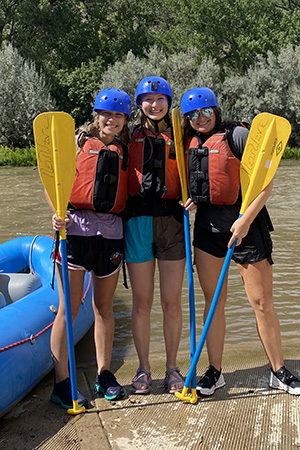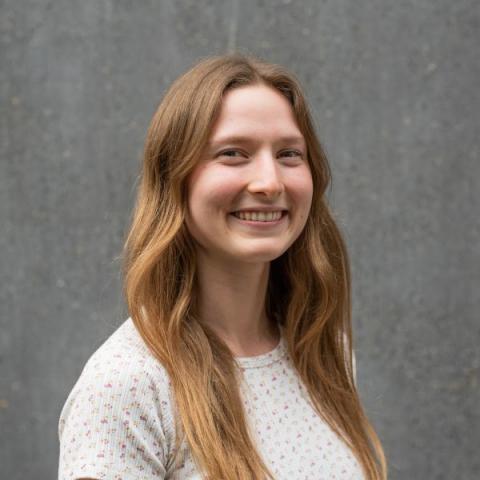Greta Gunning, an environmental health major in the UW Department of Environmental & Occupational Health Sciences (DEOHS), interned with the Indian Health Service in New Mexico last summer through the Junior Commissioned Officer Student Training and Extern Program. We recently spoke with her about her experience becoming a lay vaccinator for dogs and cats, her insights into building public health relationships in communities and the classes that have inspired her in her DEOHS studies.
How did you decide to major in environmental health?
When I first came to UW, I was on a pre-med track and drawn to biology. I took the Introduction to Environmental Health class taught by DEOHS Associate Teaching Professor Tania Busch Isaksen, and I really enjoyed it.
It seems like a more tangible application of the hard sciences, which I enjoy, into the public health field. After I took that class, I thought, this is what I'm interested in doing.
Tell me about your internship.
I did the Junior Commissioned Officer Student Training and Extern Program (JRCOSTEP), which is sponsored by the Commissioned Corps of the US Public Health Service. I worked with the Office of Environmental Health in the Indian Health Service (IHS) in New Mexico for 10 weeks last summer.
I was based in Taos, in northern New Mexico, but the Albuquerque Area IHS serves all of New Mexico, as well as some tribes in lower Colorado and northern Texas. So I got to travel all across the state. I spent about half of my time in the field, which I really enjoyed.
What did you focus on during your internship?
For my independent project, I worked with the Animal Control and Welfare committee in Taos Pueblo.
They have dealt with several challenges with animal control. My job was to try to get the community's feedback on the issue. So I created a survey and went along with community members to distribute that survey, and we analyzed the data.

For example, we asked, do you feel safe walking, running and biking on pueblo land? The majority of people said they didn’t feel safe because they were scared of being chased by dogs, and the possibility of rabies or being attacked.
The Office of Environmental Health in the IHS provides free rabies vaccinations for pueblos. I got trained to be a lay vaccinator, and vaccinated dogs and cats.
We also offered a spay and neuter clinic along with a veterinarian organization, and I distributed my survey there. It was interesting to see people being able to visualize what services they could be provided if they were to tell us their concerns.
What other projects were you involved in?

I did a wide variety of things. I went on food and restaurant inspections of businesses on tribal lands. We also did playground inspections and assessed agricultural water contamination.
I helped with lead investigations for kids in Head Start programs. If a child had high blood levels, we worked with public health nurses and physicians to do a home investigation. That involved interviewing the parents to determine sources where there could be lead, like in paint, soil or water. If necessary, soil or paint testing would occur.
What did you learn from the experience?
This was my first job in the environmental public health field. It was awesome to be surrounded by people who are so passionate and knowledgeable about public health. My mentor had completed her master's degree while she was working full time. I liked talking to her about how she had balanced that.
What did you find most illuminating?
It was really impactful to work with the tribes. The IHS Office of Environmental Health is not regulatory, which is very different than state or county environmental health agencies, which are regulatory.
One of the biggest differences I saw was that relationships are prioritized before regulations. The people whose businesses we were inspecting were receptive and excited to see us, in contrast with the times I shadowed a food inspector at restaurants (on nontribal land) in a food safety class last year.
It was great to see how prioritizing relationships could make a meaningful impact in public health.

How did it affect your plans for the future?
I was exposed to such a broad variety of environmental health activities that could apply to a career in my future. I liked doing the lead home investigations and water testing, which involved a bit of harder science. But I also enjoyed seeing the relationships involved in all the projects.
I also enjoyed working in the field and with a government agency, and I would hope to do that in the future versus working for a private organization.
You’ll be graduating this spring. What has your experience been like in DEOHS?
I've learned a lot from every class I've taken. Right now I'm taking a Disasters and Public Health class with DEOHS Assistant Professor Nicole Errett. It’s really cool, and it was not something that I expected to be interested in.
I’ve also appreciated how professors share how their own research is connected to what they are teaching, and how excited they are about it.
I love how there is a combination of interesting, fun elective environmental health classes, and also lab-based science classes where you're going out into the field and taking samples.

